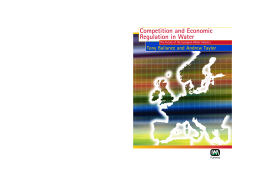
Additional Information
Book Details
Abstract
Competition and Economic Regulation in Water: The Future of the European Water Industry reviews the main developments in economic regulation and competition in the European water industry and considers ways in which economic regulation and competition should be further developed. The book focusses on the best means of regulating or introducing competition into the industry in light of its present structure. Competition and Regulation in Water: The Future of the European Water Industry concentrates on the water industry, however, many of the conclusions are equally applicable also to the wastewater industry. Contents Introduction Water industry fundamentals: the rationale for regulation and the scope for competition A framework for evaluating different models of water industry regulation England & Wales: private ownership and independent regulation France: competition for the market and contract-based regulation Germany: public-private partnerships and multi-sector utilities Developing water sector regulatory frameworks in less developed countries Appendix: The legislative framework for the water industry in England & Wales
Table of Contents
| Section Title | Page | Action | Price |
|---|---|---|---|
| Competition and Economic Regulation in Water | ii | ||
| Contents | vi | ||
| 1 Introduction | 1 | ||
| 2 Water industry fundamentals: the rationale for regulation and the scope for competition | 4 | ||
| 2.1 Key issues in natural monopoly regulation | 4 | ||
| 2.2 Potential for competition in water services | 9 | ||
| 2.3 Are there any successful models of water competition? | 17 | ||
| 2.4 Water as a natural monopoly? A few conclusions | 18 | ||
| 3 A framework for evaluating different models of water industry regulation | 20 | ||
| 3.1 Sector performance criteria | 21 | ||
| 3.2 Regulatory process performance criteria | 24 | ||
| 3.3 Institutional design criteria | 27 | ||
| 4 England & Wales: private ownership and independent regulation | 29 | ||
| 4.1 Overview of the water and wastewater industry in England & Wales | 29 | ||
| 4.2 Water sector regulatory institutions | 32 | ||
| 4.3 Key issues in economic regulation in England & Wales | 35 | ||
| 4.4 Strengths and weaknesses of the regulatory regime for water in England & Wales | 54 | ||
| 4.5 Directions for future reform | 74 | ||
| 5 France: competition for the market and contract-based regulation | 82 | ||
| 5.1 Overview of the French water and wastewater industry | 82 | ||
| 5.2 Structure of private sector participation | 85 | ||
| 5.3 Distribution of water sector regulatory authority | 87 | ||
| 5.4 Regulation of private sector participation in the water sector | 89 | ||
| 5.5 Strengths and weaknesses of the regulatory regime for water in France | 94 | ||
| 5.6 Direction of future reforms | 105 | ||
| 6 Germany: public–private partnerships and multi-sector utilities | 108 | ||
| 6.1 Overview of the German water and wastewater industry | 108 | ||
| 6.2 The role of the Stadtwerke: multi-sector utility enterprises | 111 | ||
| 6.3 Models of private sector participation | 112 | ||
| 6.4 Distribution of regulatory authority | 114 | ||
| 6.5 Economic regulation | 115 | ||
| 6.6 Strengths and weaknesses of the regulatory regime for water in Germany | 116 | ||
| 6.7 Direction of future reforms | 119 | ||
| 7 Developing water sector regulatory frameworks in less developed countries | 121 | ||
| 7.1 Regulation ‘by contract’ | 122 | ||
| 7.2 Contracts, institutions and regulation | 123 | ||
| 7.3 Conclusion | 126 | ||
| Appendix 1: The legislative framework for the water industry in England & Wales | 127 | ||
| Bibliography | 135 | ||
| Index | 143 |
